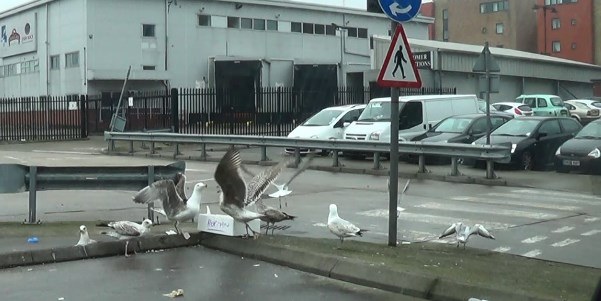Differences in kleptoparasitism between an urban and a coastal gull population
LINKED PAPER
Kleptoparasitism in gulls Laridae at an urban and a coastal foraging environment: an assessment of ecological predictors. Spencer, R., Russell, Y.I., Dickins, B.J.A. & Dickins, T.E. 2017. Bird Study. DOI: 10.1080/00063657.2016.1249821. VIEW
Populations of UK gull (Laridae) species have shown significant declines over the past half century and a number of these species are now a conservation priority in the UK. These include the Herring Gull (Larus argentatus), Great Black-backed Gull (Larus marinus), Common Gull (Larus canus) and Black-headed Gull (Chroicocephalus ridibundus), which were the study species for this research. These four species are all now red and amber listed as species of conservation concern (Eaton et al. 2015). Despite their overall downwards trends, the populations of some of these species have been increasing in urban areas (Rock, 2005). Investigating the behaviours that are allowing these species to colonise urban environments is critical to understanding how they might overcome recent population declines.
Species’ colonising novel environments have to overcome several problems, arguably the most pressing of which is identifying and acquiring food. Gulls invest heavily in food stealing (kleptoparasitic) behaviours (Brockmann & Barnard, 1979) and these behaviours have been shown to be a facultative response to changing environmental conditions (Maniscalco & Ostrand, 1997). Kleptoparasitic behaviour is significant because it allows gulls to avoid the full costs of the foraging cycle by exploiting food discovered by another individual’s effort. We speculated that kleptoparasitism may support invasive behaviour by gulls by providing an effective way for these birds to meet their energy requirements when faced with novel or changed environmental conditions. In light of this, we hypothesised that kleptoparasitism would occur at a higher rate in urban gull populations than in populations in more traditional coastal foraging environments. Additionally, we sought to identify which ecological variables best predicted any difference in the rate of kleptoparasitism seen between these environments.
Over the course of a year, fieldwork was conducted to record kleptoparasitic behaviour in mixed-species foraging flocks of gulls. The kleptoparasitic interactions of interest were gulls stealing from other gulls. This research was conducted at two study sites. The first was at Brancaster Beach, Norfolk, UK. This is a large sand beach area where gulls aggregate to forage at low tide, exploiting fish, crustaceans and marine invertebrates exposed or trapped by the receding tide. This site was considered to be typical of the shoreline foraging ecologies that gull species might have encountered throughout their evolutionary history (Figure 1). The second site was Billingsgate Market, London, UK. This is a commercial seafood market where a population of gulls forage in the car park areas of the site, exploiting seafood discards and anthropogenic food waste. The population at Billingsgate was considered to be a stable urban population of gulls (Figure 2).


We used a Generalised Linear Model (GLM) to analyse the data collected through fieldwork. The predictors were several ecological variables: the size of food items (prey size); population density (birds/m2); season (dichotomised as: breeding/ non-breeding); species of gull; and study site (coastal/ urban). The response variable was the rate of kleptoparasitism recorded. We used a sequential approach to fit models using the Akaike Information Criterion (AIC), this led to the removal of season and species from the model as they were not significant predictors of kleptoparasitism. The best fitting model contained population density, prey size and site as significant predictors of kleptoparasitism. Kleptoparasitism was significantly higher at the urban site (Billingsgate), a higher population density and larger prey size in the urban environment were the best predictors of this higher rate of kleptoparasitism. Of these, the best predictor of kleptoparasitism was the higher population density observed in the urban environment at Billingsgate.
Our results suggested that kleptoparasitism may aid invasion and increase the range of environments a gull can tolerate by helping them meet their energy needs in novel environments where normal foraging behaviours are difficult to implement. Kleptoparasitic strategies appear most effective when individuals are forced to forage together at higher densities and food items are large enough to provide conspicuous visual cues highlighting the presence of food.
References
Brockmann, H.J. & Barnard, C.J. 1979. Kleptoparasitism in birds. Animal Behaviour 27: 487-514.
Eaton, M.A., Aebischer, N.J., Brown, A.F., Hearn, R., Lock, L., Noble, D.G., Musgrave, A.J., Noble, D.G., Stroud, D. & Gregory, R.D. 2015. Birds of conservation concern 4. British Birds 108: 708-746.
Maniscalco, J.M. & Ostrand, W.D. 1997. Seabird behaviors at forage fish schools in Prince William Sound, Alaska. In Forage Fishes in Marine Ecosystems. Proceedings of the International Symposium on the Role of Forage Fishes in Marine Ecosystems. Alaska Sea Grant College Program Report No. 97-01, p.175-190, University of Alaska Fairbanks, 1997.
Rock, P. 2005. Urban gulls: problems and solutions. British Birds 98: 338-355.
Image credit
Featured image: Urban gulls © Rob Spencer
If you want to write about your research in #theBOUblog, then please see here.





